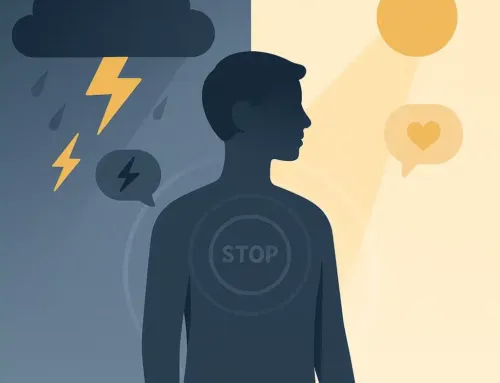
Approx. read time: 13.1 min.
Post: The Hidden Cost of Running on Empty: Understanding, Spotting, and Stopping Burnout Before It Breaks You
How to prevent burnout in the workplace. Burnout isn’t just feeling tired after a long week—it’s a chronic, deep-seated depletion of mental, emotional, and physical resources. In today’s always-on world, burnout has become an epidemic: deadlines that multiply, inboxes that never empty, and expectations that keep ratcheting up. Left unchecked, burnout can derail your productivity, sap your creativity, damage your health, and poison relationships.
This article unpacks why burnout happens, how to recognize the early warning signs, and concrete strategies to prevent it—or halt it in its tracks if it’s already begun. Treat this guide as a toolkit: pick the tactics that fit your life, adapt them to your needs, and start building a sustainable rhythm of high performance plus real recovery.
Why People Burn Out – And How to Prevent Burnout in the Workplace
Burnout doesn’t happen overnight. It builds, layer by layer, until even the most motivated employees hit a wall. Understanding the root causes is the first step to fixing the system, not just the symptoms.
1. Chronic Overload
Burnout often begins with too much work and too little time. It’s not just the volume—it’s the relentlessness. When your to-do list grows faster than you can tackle it, every win feels like a drop in the ocean. Half-finished projects pile up. Slack messages never stop. Meetings devour your calendar. “Urgent” becomes meaningless because everything’s urgent.
This state of constant activation keeps your brain locked in stress mode. Cortisol surges. Focus declines. Decision-making gets sloppy. Eventually, your body treats every day like a crisis—because it is. Without space to recover, your output tanks, no matter how hard you try to push through.
Prevent It:
Leaders need to normalize sustainable workloads. Prioritize projects clearly. Eliminate busywork. Build in white space between deadlines. If everything’s a priority, nothing is.
2. Loss of Control
People burn out fast when they feel like cogs in a machine. If you can’t set your own goals, influence your schedule, or choose how you do your work, it’s easy to slip into learned helplessness. You show up, but you disengage. You execute, but you stop caring.
The bigger the gap between responsibility and control, the more energy it takes to stay motivated. Constant micromanagement, rigid structures, or shifting priorities from above leave employees feeling disoriented and resentful. Autonomy isn’t a luxury—it’s a buffer against burnout.
Prevent It:
Give people room to own their work. Trust them with decisions. Let teams experiment, even if it means mistakes. Autonomy fuels energy and innovation—tight control kills both.
3. Misaligned Values
Even a well-paying job can burn you out if the work feels meaningless. When what you do every day doesn’t reflect what you care about, it drains you. You start to question why you’re even doing it. Maybe you value creativity, but your job is process-driven. Maybe you want to make a difference, but you’re stuck chasing KPIs that don’t.
This misalignment creates a slow leak in motivation. You do the job, but it never clicks. Over time, that gap erodes your sense of purpose and leads to quiet quitting—or a total crash.
Prevent It:
Hire for fit, not just skills. Talk openly about values during reviews and one-on-ones. Redesign roles so people spend more time on tasks that light them up. When people believe in the mission, they bring more to the table.
4. Insufficient Recovery
Burnout isn’t just about what you do—it’s about what you don’t do: rest. Skipping breaks, pushing through fatigue, and bragging about “no days off” might earn praise short term, but it’s a recipe for long-term damage.
Recovery isn’t optional—it’s a biological necessity. Without it, your body stays in a chronic stress loop. That leads to sleep issues, mood swings, reduced immunity, and eventually full-blown exhaustion. And unlike a phone battery, people don’t recharge just by “doing nothing.” We need real, intentional recovery.
Prevent It:
Encourage time off—and mean it. Model healthy boundaries. Build breaks into the culture: walking meetings, no-meeting blocks, mental health days. Make recovery part of the workflow, not something people have to earn.
5. Lack of Support
Burnout hits harder when you feel like you’re on your own. In workplaces where asking for help is seen as weakness, or where no one has your back, pressure compounds. You’re not just managing your tasks—you’re managing your fear of failing with no safety net.
Support isn’t just about having a friendly coworker. It’s about access to mentorship, clear communication, shared goals, and a culture that encourages collaboration over competition. When people feel seen, supported, and safe to speak up, they can weather high-pressure moments without falling apart.
Prevent It:
Build strong teams, not just strong individuals. Encourage peer check-ins. Train managers to notice the early signs of overload. Celebrate teamwork, not just heroics. People are more resilient when they know they’re not alone.
Bottom Line:
Burnout is a system failure, not a personal one. If your team is burning out, it’s not because they’re not tough enough—it’s because something in the environment is off. Fix the environment, and performance, engagement, and well-being all rise together.
Recognizing the Warning Signs of Burnout – How to Prevent Burnout in the Workplace
How to Prevent Burnout in the Workplace: Strategies and Solutions
Burnout rarely announces itself with a bang. It creeps in quietly, masking itself as fatigue, stress, or just “a rough week.” But left unchecked, it can tank your motivation, health, and productivity for months. Catching it early is crucial. Look out for patterns—not just isolated bad days—across five key domains:
1. Emotional Exhaustion
This is the emotional drain that makes everything feel heavier than it should. It’s not just being tired—it’s being spent.
-
You wake up already dreading the day, no matter how much you slept.
-
You feel emotionally numb or detached—like you’re going through the motions with nothing left to give.
-
Little irritations hit like big ones. You snap at colleagues, roll your eyes at meetings, or get unreasonably frustrated at home.
What to do:
This is your cue to stop pretending you’re fine. Normalize mental health check-ins, take emotional fatigue seriously, and step back before the cracks widen.
2. Cynicism and Detachment
Burnout doesn’t just drain your energy—it warps your perspective. What once felt meaningful now feels like a grind.
-
You’ve stopped caring about outcomes—“It’s not like it matters anyway.”
-
You find yourself disengaging from meetings, skipping brainstorming sessions, or mentally checking out during the workday.
-
You see colleagues’ enthusiasm as naïve or annoying. You’ve adopted a default tone of sarcasm or apathy.
What to do:
Cynicism is a warning light, not a personality trait. Leaders should open the door to honest conversations about purpose and workload. Employees should ask: When did this start feeling hollow—and what changed?
3. Performance Decline
Burnout isn’t laziness. In fact, most burned-out people are working harder than ever—just with diminishing returns.
-
Deadlines slip because your focus is shot, not because you’re slacking.
-
You’re putting in hours but not producing your best work. Creativity flattens. Solutions feel forced.
-
You’re constantly multitasking but making little actual progress. You’re busy—but not effective.
What to do:
Track output over time. If you’re grinding harder and producing less, stop and reassess. Managers should focus on outcomes, not just hours logged, and adjust expectations accordingly.
4. Physical Red Flags
The body keeps the score. Stress, when ignored, shows up physically.
-
Recurring headaches, tight shoulders, or unexplained muscle tension.
-
Digestive issues like nausea, bloating, or random shifts in appetite.
-
Sleep is off—you struggle to fall asleep, wake up at odd hours, or sleep a full night and still feel wiped.
What to do:
Don’t brush this off as “just stress.” These are your body’s alarms. Employers should create cultures that respect rest—encouraging real lunch breaks, walking meetings, and actual sick days.
5. Behavioral Shifts
Sometimes, the biggest clues are in what you start doing—or stop doing.
-
You lean harder on caffeine, sugar, or alcohol to stay afloat.
-
You cancel plans because you’re too drained to talk to anyone.
-
You procrastinate on basic tasks—answering emails, updating a doc, even replying to a text—because everything feels like too much.
What to do:
Watch your habits. If your coping mechanisms are starting to look like escape routes, take action. Peer support, mental health resources, and adjusted workloads are better solutions than burnout band-aids.
When to Intervene
If two or more of these signs show up consistently for two or more weeks, don’t wait. That’s not “just a bad month”—that’s burnout taking root.
Next Steps:
-
For individuals: Speak up. Take a day off. Reassess boundaries. Seek support.
-
For managers: Check in—not just about deadlines, but about energy, clarity, and morale.
-
For companies: Build burnout prevention into your systems—not just in HR policies, but in day-to-day culture.
Strategies to Prevent Burnout in the Workplace: How to Prevent Burnout in the Workplace
Burnout doesn’t hit all at once. It builds when high demands meet low control, constant output meets little recovery, and day-to-day work loses its meaning. Prevention isn’t about working less—it’s about working smarter, more intentionally, and with built-in systems for rest and alignment.
Here’s how to build burnout resistance from the inside out.
A. Boundary Setting: Protect Your Time, Energy, and Attention
You can’t stay in high gear 24/7. Boundaries are your brakes.
-
Block deep work time. Carve out at least three 60–90 minute blocks a week where you’re unreachable—no meetings, no notifications. This is where high-impact thinking gets done.
-
Create a shutdown ritual. End each workday with a checklist review and a hard stop. Log off, close your laptop, and switch mental gears—ideally with a post-work walk, dinner, or hobby.
-
Defend your calendar. Say “no” more often. Decline meetings without a clear purpose. Delegate or drop non-essential commitments. A full schedule isn’t a badge of honor—it’s a drain.
Pro tip: Set email boundaries. No replies after hours unless it’s urgent. Create “catch-up” time blocks to avoid constant inbox multitasking.
B. Smart Delegation: Get Strategic About What You Own
Burnout thrives when you try to do everything yourself. You don’t have to.
-
Audit your workload weekly. Write down everything you did. Then highlight what only you should be doing. The rest? Delegate, automate, or cut.
-
Play to strengths. Assign tasks based on what your teammates are best at—not just what’s available. This improves speed, quality, and morale.
-
Be specific when handing off. Define success clearly: What’s the deadline? What does “done” look like? What’s optional vs. non-negotiable?
Mindset shift: Delegation isn’t dumping work. It’s distributing impact so you can focus on what matters most.
C. Built-In Recovery: Schedule Recharge Like You Schedule Meetings
You can’t grind your way through burnout. Recovery has to be part of the routine—not an afterthought.
-
Use micro-resets. Every hour or so, step away. Stretch, take 10 deep breaths, or do a quick walk around the block. Small resets prevent large crashes.
-
Take a digital sabbath. Go offline one afternoon a week. No Slack, no emails, no task lists. Let your brain breathe.
-
Plan real time off. Book at least two weeklong vacations a year—and actually disconnect. No inbox checking “just in case.” That defeats the purpose.
Remember: Hustle culture glorifies nonstop effort. High-performance culture protects energy so you can sustain it.
D. Aligning Values and Priorities: Work That Means Something Burns You Out Less
When your actions match your values, you feel energized. When they clash, you feel drained—even if the work is technically “easy.”
-
Pick your “Big Three” every Monday. Decide which three outcomes matter most this week. Let that steer your focus and filter distractions.
-
Track progress, not perfection. Each day, write down one win—big or small. This keeps momentum visible and combats the feeling of “never enough.”
-
Check your alignment monthly. Ask: Does this still feel worth it? Am I proud of how I spend my time? If not, course-correct early—don’t wait for a breakdown.
Key idea: Meaning protects against burnout. But you have to check in often to keep your compass pointed true.
How to Stop Burnout from Getting Worse
How to Prevent Burnout in the Workplace: Essential Insights
Already sliding into the burnout zone? You can’t power through it—you have to interrupt it.
Here’s how to reverse the trend:
1. Emergency Rest Protocol
When you feel the signs of burnout (irritability, brain fog, dread), act fast.
-
Take a micro-vacation. Half a day off—no email, no planning, no to-do lists. Just rest and reset.
-
Do a home retreat. One evening a week: lights dimmed, no devices, gentle movement, early sleep. Let your nervous system offload stress.
2. Open the Feedback Loop
Silence keeps burnout festering. Talking about it opens the door to solutions.
-
Start peer check-ins. Have a standing 15-minute coffee chat with a trusted colleague each week. Swap strategies, share what’s hard, offer mutual accountability.
-
Debrief with your manager. Frame it around impact: “Here’s what’s stretching my bandwidth—can we align on top priorities to keep quality high?”
Pro tip: Clarity kills chaos. The more aligned you are, the less stressed you’ll feel.
3. Professional Support
Burnout often goes deeper than a nap can fix. Know when to escalate.
-
Therapy or coaching. If you’re stuck in stress loops, struggling with sleep, or feeling emotionally flat, a professional can help rewire your coping strategies.
-
Use your EAP. Many companies offer free short-term counseling or stress coaching. Don’t wait until you’re falling apart to use it.
4. Physical Reset Techniques
You can’t think your way out of burnout—you also need to move and nourish your body.
-
Try a daily mind-body practice. Even 10 minutes of yoga, stretching, or breathwork can reduce anxiety and regulate mood.
-
Get outside. Natural light and green spaces lower cortisol. A 15-minute walk can shift your mindset more than an hour of scrolling.
-
Clean up your habits. Cut back sugar, eat nutrient-dense meals, and set a consistent sleep routine—even on weekends.
Conclusion: Burnout Isn’t Inevitable—You Get to Draw the Line
Burnout isn’t a badge of commitment. It’s a signal that something needs to change.
By setting strong boundaries, delegating strategically, building in recovery, and aligning your work with your values, you take back control of your energy and impact. Burnout doesn’t happen because you’re weak. It happens when systems fail. You can redesign those systems.
You don’t have to earn rest. You need rest to do your best.
So make recovery part of your strategy—not your last resort. Your health, your work, and your life will all be stronger for it.
Related Videos:
Related Posts:
Cybersecurity burnout: 10 most stressful parts of the job
4 Powerful Morning Affirmations
Skin 5 Ways to Build Healthy Glowing Skin Naturally
Hippocampus Health and Aging 7 Powerful Strategies
In and out of Love: The 7 Truths Behind it All
Pride in Religion: Healthy vs Unhealthy
The Rise of Online Health Information in Canada: A Symptom of a Strained Healthcare System
Micromanaging and Its Impact on Mental Health: Understanding the Positive and Negative Sides
Self-Development & Inspiration: Tools and Strategies for Personal Growth









